Tumors of the Kidney and Urinary Tract – Flashcards
Unlock all answers in this set
Unlock answersquestion
Bladder cancer: mostly females or males? what age is commonly affected? What cell type is usually affected?
answer
Bladder cancer: mainly males mainly 50-80 yo usually epithelial tumors (*urothelial, squamous cell, adenocarcinoma, small cell)
question
How does bladder cancer typically present?
answer
-painless hematuria -irritative symptoms (frequency, urgency, dysuria) -hydronephrosis (if ureteral orifice involved) -at presentation, most are
question
Renal cancer - more commonly men or women? Older or younger pts?
answer
men; older
question
What's the most common type of renal cancer?
answer
renal cell carcinoma
question
What is the most important risk factor for both renal and bladder cancers?
answer
tobacco use
question
Is schistosoma haematobium infection a risk factor for bladder or renal cancer?
answer
bladder
question
How does bladder cancer often present? How about renal cancer?
answer
-Bladder - [presents Badder] - painless hematuria; can have irritative voiding; pelvic/suprapubic pain; pelvic mass. -Renal - often asymptomatic, found incidentally (50%); triad of flank pain/hematuria/mass only in 10%; paraneoplastic; often asymmetric
question
What is the pneumonic for hematuria Ddx?
answer
Pee Pee ON TTTTHIS [Hey ya 1 2 3 4] Obstruction Nephritis Trauma Tumor TB Thrombosis (renal vein) Hematologic Infection/inflammation Stones
question
Of the following, which are benign/malignant: renal cell carcinoma renal adenoma oncocytoma angiomyolipoma urothelial carcinoma metastatic tumor abscess infarct ateriovenous malformation pseudotumor
answer
Benign renal adenoma oncocytoma angiomyolipoma
question
Likelihood of renal mass malignancy depends on ________
answer
size
question
Can imaging reliably distinguish benign from malignant?
answer
NO! (unless intratumor fat - angiomyolipoma)
question
What are the significant subtypes of renal cell carcinoma? What is the most common?
answer
-most common = clear cell carcinoma -papillary carcinoma -chromophobe carcinoma -CD carcinoma -Xp11 translocation carcinoma (mostly in young/ped pops - think young kids and their Xbox 11 listening to Ri Ri - renal cell carcinoma)
question
What's the most common familial syndrome associated with renal cell carcinoma? What gene is mutated? What is the inheritance pattern? How does it present?
answer
Von Hipple Lindau Syndrome (classy name - gonna be classy cancer - renal not bladder) -autosomal dominant mutation of VHL gene on 3p25 -often leads to multifocal, bilateral, multiple renal cell carcinomas at early age [Others: hereditary leiomyomatosis & RCC syndrome; Birt-Hogg-Dube syndrome; Hereditary Papillary Carcinoma]
question
Is the VHL gene an oncogene or tumor suppressor gene? How does it work?
answer
VHL is a tumor suppressor gene (VEHLL THEN = suppressive). It degrades the protein HIF-1alpha which induces VEGF, CA-IX -> formation of vasculature -> progression of tumor
question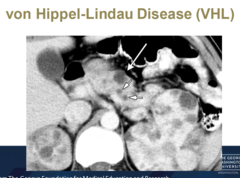
How does clear cell RCC usually present? Is it solitary? Unilateral? Sporadic?

answer
-usually solitary and unilateral -usually in kidney poles -usually sporadic -occurs at an earlier age if VHL
question
Renal tumor workup
answer
-H + P - bp, skin, neuro -CT/MRI - evaluate mass, vessel involvement, contralateral kidney, regional lymph nodes, metastasis -CXR -CBC, BMP, Liver function/Alk Phos -look for paraneoplastics (think P close to R for renal rather than bladder); bone scan if elevated alk phos or bone pain
question
How do you treat renal tumors? What's the gold standard?
answer
*Renal tumors are really *Resistant -; chemo and radiation are not effective -; SURG = GOLD STANDARD (radical ;4 cm or partial ;4 cm nephrectomy; cryosurgery; radiofrequency ablation)
question
Do you often need biopsies for renal cancers?
answer
No! majority of solid masses are malignant
question
When might you do a renal biopsy?
answer
if you suspect - lymphoma, bilat masses, multiple masses, diagnostic dilemmas, prior to focal ablative therapy, metastasis
question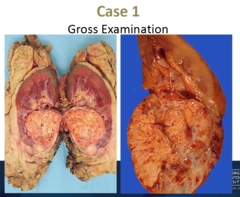
How does clear cell carcinoma appear grossly?

answer
[Be guided by the name - CLEAR cell carcinoma bc the cells are clear because of their glycogen and fat content] -circumscribed mass, sharp margins -bright yellow-orange because of lipids and glycogen -large areas of gray/white necrosis -hemorrhage common
question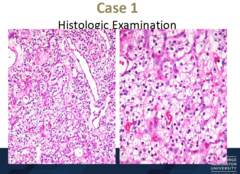
How does clear cell carcinoma appear histologically?

answer
-round cells with clear cytoplasm bc of glycogen and fat -delicate branching vasculature: chicken wire appearance (all these little clear cages for chickens) - separates tumor nests and tubules
question
What's the grading system for renal cell carcinomas? What's it based on?
answer
-4-tiered system by Fuhrman -based on nuclear size, pleomorphism, nucleolar size;
question
What's the staging system used for renal cell carcinomas? What's it based on?
answer
TNM Stage 1: cancer in kidney only and 7 cm Stage 3: spread to nearby tissue but not past kidney/adrenal Stage 4: metastasis
question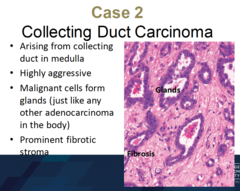
Are collecting duct carcinomas malignant or benign? Are they common or rare? What type of carcinoma are they? What are some key features? Are they peripheral or central?

answer
Collecting duct carcinoma = -very aggressive -rare -an adenocarcinoma -; so the malignant cells form glands -prominent fibrotic stroma [I want to COLLECT you up in my glands!] -central
question
What is the most common benign tumor of the kidney?
answer
angiomyolipoma
question
How does fat show up on CT?
answer
black
question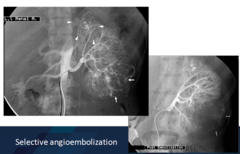 4cm)" alt="Angiomyolipoma: -What type of cancer may it grossly and radiographically mimic? -What is the tumor composed of? -what might it do to the vessels if it gets big (;4cm)">
4cm)" alt="Angiomyolipoma: -What type of cancer may it grossly and radiographically mimic? -What is the tumor composed of? -what might it do to the vessels if it gets big (;4cm)">
Angiomyolipoma: -What type of cancer may it grossly and radiographically mimic? -What is the tumor composed of? -what might it do to the vessels if it gets big (;4cm)
 4cm)" alt="Angiomyolipoma: -What type of cancer may it grossly and radiographically mimic? -What is the tumor composed of? -what might it do to the vessels if it gets big (;4cm)">
4cm)" alt="Angiomyolipoma: -What type of cancer may it grossly and radiographically mimic? -What is the tumor composed of? -what might it do to the vessels if it gets big (;4cm)">answer
Again, use the name to guide you -can mimic RCC -tumor composed of vessels (angio), SM (myo), and fat (lipo) - >4cm -> selectively angioembolize -can hemorrhage extensively
question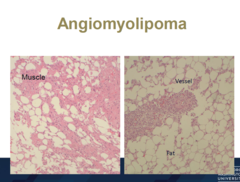
pics of angiomyolipoma

answer
creates thick walled vessels that are abnormally shaped
question
Angiomyolipoma is often associated with what condition? What are the implications?

answer
-Angiomyolipoma found in 25-50% pts with tuberous sclerosis -> affects a lot of systems -> -cerebral cortex lesion -> epilepsy, mental retardation -skin abnormalities (sebacious cysts) -other benign tumors, especially in the heart [Think: lot of parts in the name -> can affect a lot of systems]
question
If you feel an abdominal mass in kids, what would you think (renally)?
answer
Wilms Tumor! (lil Willy!) = most common kidney tumor of children, often 2-5 yo, presents as palpable mass
question
Is Wilms Tumor usually unilateral or bilateral? How does management change for each situation?
answer
-usually unilateral -if unilateral -> surg followed by chemo and possibly radiation -if bilateral -> start with chemo (defies the surg first paradigm)
question
What's are some of the genetic syndromes associated with Wilms Tumor? What gene is affected in Wilms tumor?
answer
1) WAGR syndrome = germline depletion of 11p13 on WT1 gene -Wilms Tumor -Aniridia (iris is not fully circumferential) -Genital anomalies -mental Retardation 2) Denys-Drash syndrome -gonadal dysgenesis, tumor -nephropathy -WT1 abnormalities (Those young Willy kids love to go to Dennys and Dash) 3) Beckwith-Wiedemann syndrome -organomegaly, macroglossia (large tongue) -hemihypertrophy -omphalocele -mutation in WT2 (BECKham and his wife - such a nice 2)
question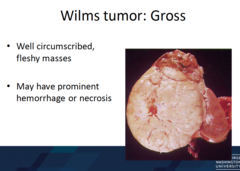
How does Wilms tumor appear grossly?

answer
-well circumscribed, fleshy -"fish flesh" -may have prominent hemorrhage or necrosis [Something seems fishy...Willy have you been a naughty boy?!]
question
Wilms tumor pathology - what are the three phases affected?
answer
-recapitulates developing kidney -3 phases = blastema (sheets of blue small cells); epithelium (abortive tubules and glomeruli); stroma (mostly fibrotic)
question
What's the prognosis for Wilms tumor?
answer
-good! current cure rate 90%. But beware of secondary malignancy -5% of tumors have anaplasia aka poorly differentiated cells (large, hyperchromatic, pleomorphic nuclei and abnml mitosis) = bad prognostic sign
question
Bladder cancer - evaluation
answer
-H + P -cystoscopy and adequate biopsy with bimanual exam (this is unique to bladder cancers!) -urine cytology -CT abd/pelvic/retrograde pyelogram (for upper tract and metastatic eval) -CXR -CBC, BMP, Liver fx/alk phos (bone scan if elevated alk phos or symptoms to indicate bony metastasis)
question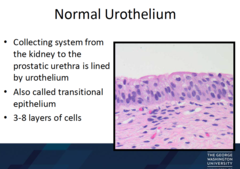
What is bladder lined by (cells)?

answer
urothelium aka transitional epithelium; 3-8 layers of cells with top umbrella layer that covers a couple cells
question
What are the most common types of bladder cancers?
answer
epithelial tumors -mainly urothelial -squamous cell -adenocarcinoma -small cell
question
In addition to stage and grade, what in particular about bladder cancers is important to consider in evaluation?
answer
architecture! flat vs. papillary = 2 distinct precursor lesions
question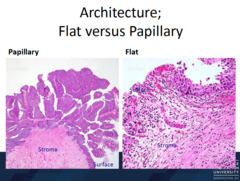
How would you describe papillary architecture? Flat?

answer
-papillary = finger-like projections, cells radiate from a fibrovascular core; can progress to invasive carcinoma -flat = in situ carcinoma; almost always progresses to invasive carcinoma
question
Which pattern - flat or papillary - is more common?
answer
-papillary is more common (think more projections -> more common) -
question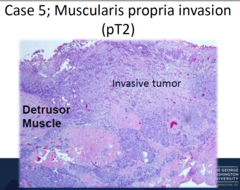
Urothelial tumor staging

answer
TNM T - presence or absence of invasion; if it invades into the bladder wall muscle it's worse
question
How do you treat bladder cancer? What do you need to determine first?
answer
First, determine if muscle invasive or not. -non-invasive - transurethral tumor resection +/- intravesical therapy (BCG, mitomycin, etc.) -Invasive: NEED multimodal treatment - cystectomy with urinary diversion +/- chemo -like renal cancer, surg moe effective than chemo/radiation
question
Is metastatic bladder cancer curable?
answer
no!
question
What is intravescial therapy? Why is it used?
answer
-intravescial therapy = chemo or immunotherapy -helps reduce relapse, eliminate residual tumor in certain kinds of bladder cancers (Ta, T1, CIS) since high recurrence and progression rates for non-muscular invasive bladder cancer
question
Intravesical therapy: what's an example of immunotherapy? Chemotherapy?
answer
-immunotherapy = BCG -Chemo = mitomycin C
question
What is mitomycin C? How does it work?
answer
mitomycin C is a chemotherapy. it's an alkylating agent -> interferes with DNA synthesis
question
What is BCG?
answer
Bacillus Calmette Guerin vaccine -By binding fibronectin, BCG activates T cells which revs up the body's immune response to the cancer
question
How is BCG administered?
answer
-induction -maintenance ^hard regimen to complete
question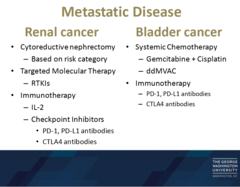
Neither metastatic renal nor bladder cancers are curable. Here are some treatment options

answer
In renal, rather than doing a nephrectomy, often give systemic therapy first rather than surg.
question
Hematuria is _______ until proven otherwise
answer
cancer
question
Grading for urothelial tumors
answer
WHO/ISUP 2004: papilloma, PUNLMP, low grade, high grade
question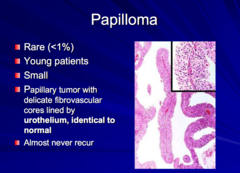
Following slides are from prework only - lower priority What are papillomas? Who do they usually affect?

answer
-papillary bladder tumor; before grade 1 even -small -affect young pts -almost never recur
question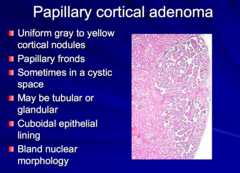
Papillary cortical adenoma Is it a kidney or bladder tumor? Benign or malignant? What's the usual size (size based definition)?

answer
kidney tumor benign usually size < 5 mm
question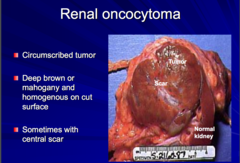
Renal oncocytoma -benign or malignant? -gross appearance?

answer
benign -circumscribed tumor, deep brown or mahogany and homogenous, can have central scar [ONCOcytoma - think of old rusty mahogany ANCHOR that's scarred]
question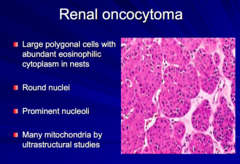
Renal oncocytoma - histo

answer
keeping with the red anchor - red eosinophilic cytoplasm -big cells - big anchors
question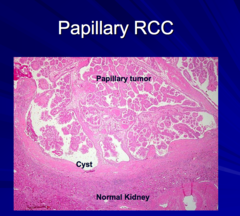
Papillary Renal cell carcinoma: -What is it? -how does it usually present (focally and laterally)?

answer
Papillary renal cell carcinoma -papillary (cells radiate from a fibrovascular core) tumor growing in a cystic space -cores may have foamy macrophages -often multifocal and bilateral -typically hemorrhagic and cystic
question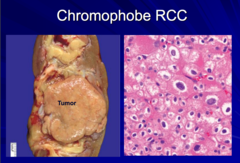
Chromophobe RCC -prognosis compared to clear cell and papillary? -gross appearance? -histo

answer
Chromophobe RCC -excellent prognosis compared to clear cell and papillary (Think chromophobe germophobe I'm paranoid so I have good prognosis) -gross: tan circumscribed mass (I'm a chromophobe and I'm tan) -Histo: may mimic oncocytoma. Cells with eosinophilic cytoplasm and a halo around raisinoid nuclei (little germophone eating my raisins and staying anchored)
question
Urothelial carcinoma of renal pelvis = a renal cancer -does it have symptoms? -better or worse prog than baldder urothelial carcinoma?
answer
Urothelial carcinoma of renal pelvis -has more symptoms than renal cell carcinomas -prognosis worse than bladder urothelial carcinoma - more commonly infiltartive



